
As seasoned professionals in the pool service industry, we understand the intricacies of maintaining a crystal-clear, healthy, and safe swimming pool. We will talk about the routine maintenance required for two pivotal components of your saltwater pool – the salt cell and the debris screen.
These often overlooked elements are integral to the effective operation of your pool and require regular attention to ensure optimal pool health.
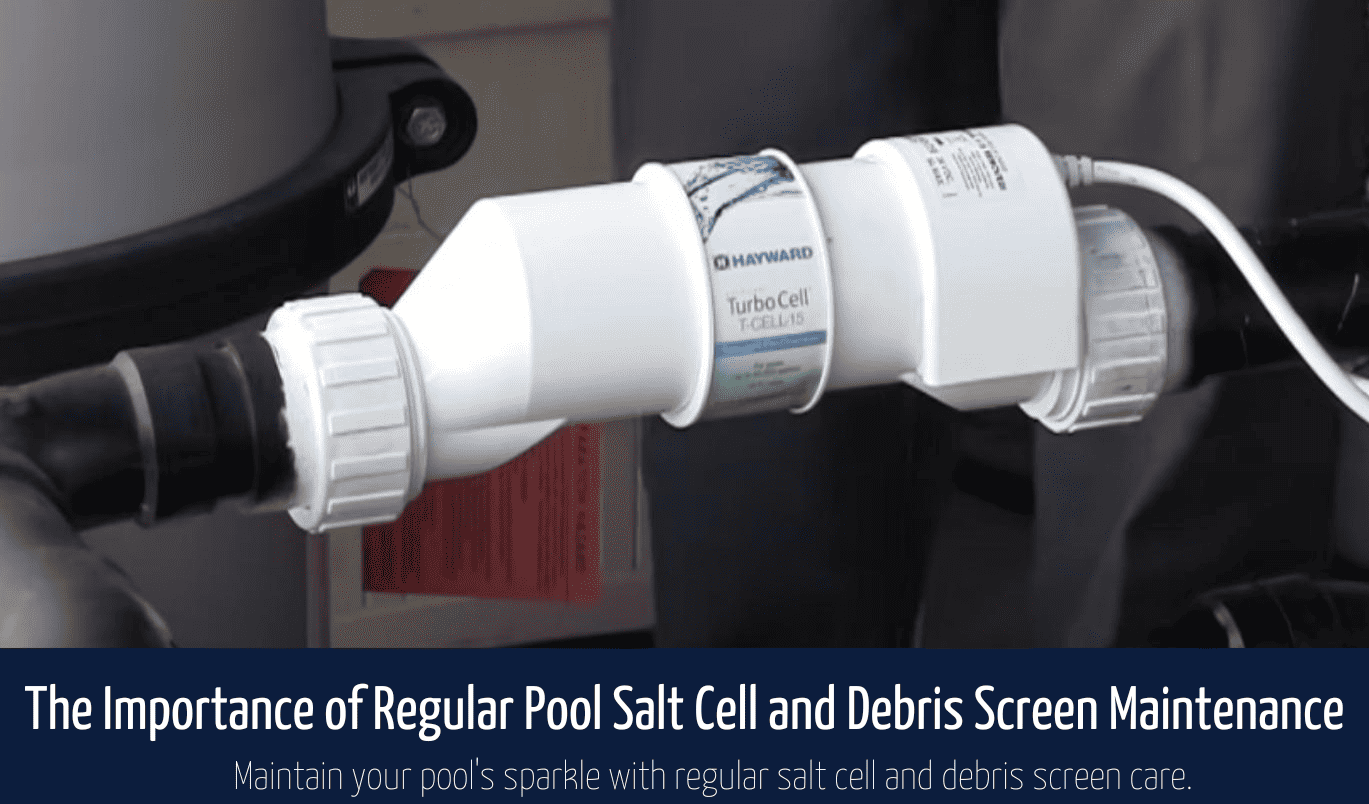
Saltwater pools are a popular choice for many homeowners due to their reputation for being gentler on the skin and eyes compared to traditional chlorinated pools.
They work by employing a salt cell, which, through the process of electrolysis, produces chlorine to sanitize the pool.
Alongside the salt cell, the debris screen is vital in preventing larger contaminants from flowing through your salt cell and causing any damage to it.
Neglecting to maintain your salt system can lead to many issues, such as deteriorated water quality, reduced water flow, and inefficiency in chlorine generation.
This post will briefly discuss how to properly maintain your salt cell and debris screen.
Whether you’re a new or seasoned pool owner, we’re here to ensure that your pool remains in peak condition for maximum enjoyment.
To understand why we need to regularly maintain the pools, knowing how a saltwater pool operates is essential.
Unlike a traditional chlorine pool, where you manually add chlorine to sanitize the water, a saltwater pool utilizes a salt chlorine generator. This special piece of equipment carries out electrolysis, using salt and electricity to create chlorine.
In a saltwater pool, you initially add a significant amount of salt, usually hundreds of pounds at first, which dissolves in the water.
Electricity is applied as the salt-infused water passes through the salt cell in the generator. This process splits the salt molecules into sodium and chlorine, producing the desired chlorine necessary for sanitization.
Once the chlorine has done its job, it reverts to salt, and the cycle continues. This process makes saltwater pools a self-sustaining system, as they constantly recycle and reuse the salt.
The heart of the saltwater pool system lies in the salt cell. This essential component of the salt chlorine generator is where the electrolysis takes place.
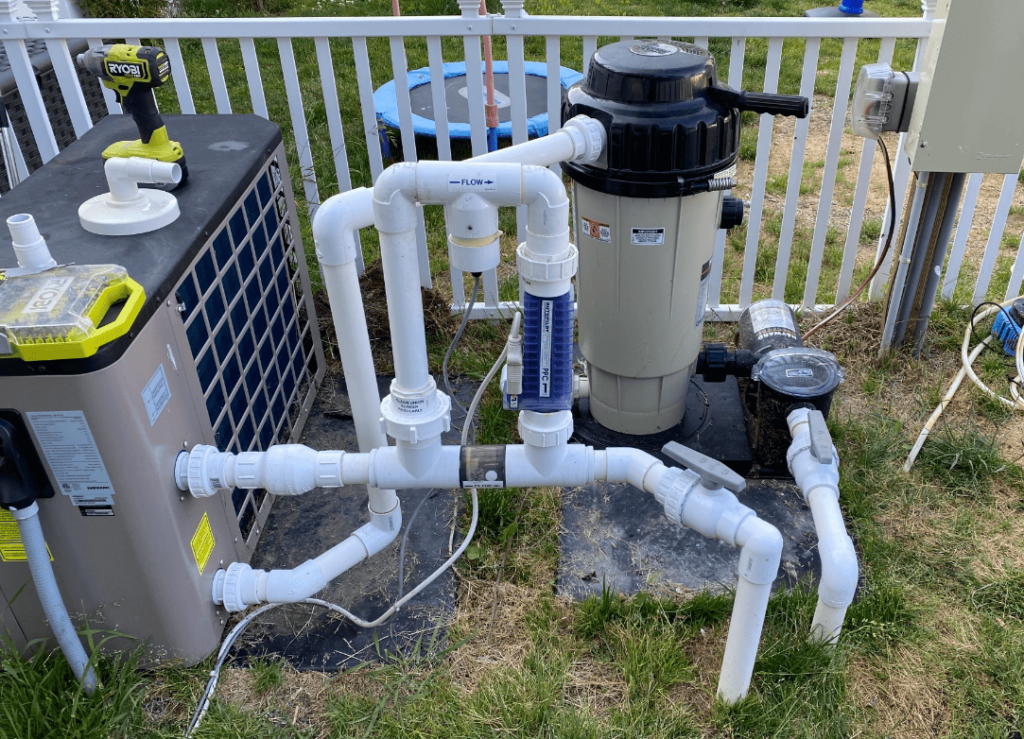
As the salt water passes over specially coated metal plates in the salt cell, electricity is introduced, converting the salt into chlorine.
This chlorine is then dispersed back into the pool, eradicating bacteria and algae and ensuring your pool water is safe and clean.
However, this process can lead to a buildup of calcium and other minerals on the metal plates of the salt cell over time, impeding the electrolysis process and potentially reducing the efficiency of chlorine production.
Regular cleaning of the salt cell helps to remove these mineral deposits and ensures the cell continues to operate at peak efficiency.
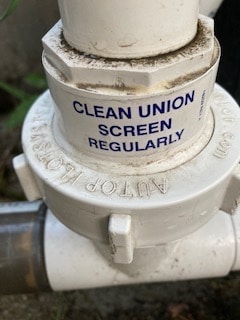
The debris screen, an essential yet often-underestimated component of the pool system, is ingeniously designed to intercept larger debris like leaves, twigs, and other organic matter before they can make their way to the salt cell.
The purpose of this screen is not to shield the pool pump or filter (which are positioned before the salt cell in a pool filter system) but rather to safeguard the salt cell itself. A clogged salt cell can impede chlorine generation, which can significantly compromise the cleanliness and safety of your pool water.
Over time, the debris screen can become clogged as particles accumulate. This can lead to water flow restriction, decreased efficiency of chlorine generation, and potential damage to the salt cell.
Regularly cleaning the debris screen helps prevent these issues and significantly contributes to maintaining the overall health and longevity of your salt cell and, by extension, your saltwater pool.
Understanding these elements and their critical roles can empower you to maintain your saltwater pool effectively, ensuring it remains a refreshing and inviting oasis for you and your loved ones.
Another crucial component to consider for preserving the life of your saltwater pool is a sacrificial zinc anode. While it may sound complex, the concept behind a sacrificial anode is quite straightforward and incredibly beneficial to the overall health and longevity of your saltwater pool system.
In simplest terms, a sacrificial anode is a piece of metal, usually zinc, that is placed in the pool’s circulation system. Its purpose is to act as a ‘sacrifice’ to protect the more valuable and essential parts of your pool system—like the pump, heater, and salt cell—from the corrosive effects of electrolysis.
Saltwater pools, by nature, are prone to galvanic corrosion due to the salt content in the water. This corrosion is a chemical reaction that occurs when dissimilar metals (for instance, the copper in your heater and the stainless steel in your pool ladder) come into contact through an electrolyte, in this case, your saltwater pool.
When you install a zinc anode, which is more reactive than other metals used in your pool system, it becomes the primary metal to undergo galvanic corrosion. Essentially, the zinc anode sacrifices itself to protect other metal components of the pool.
Installing a sacrificial zinc anode in your saltwater pool has several benefits:
Installing a sacrificial zinc anode is a proactive and recommended measure to protect and preserve your saltwater pool system. By understanding and implementing such preventative measures, you ensure the longevity of your pool components, maintain the efficiency of your system, and ensure your saltwater pool stays refreshing and inviting for years to come.
We can’t stress enough the potential problems that can arise from neglecting the regular maintenance of your saltwater pool.
Firstly, let’s talk about the issue of reduced chlorine generation.
Over time, a salt cell can accumulate calcium deposits and other minerals, especially in areas with hard water.
These deposits can coat the metal plates in the salt cell, hampering the electrolysis process and decreasing the cell’s ability to produce chlorine effectively.
Reduced chlorine generation may result in the pool water becoming cloudy, green or even leading to algae growth, which is not conducive to a pleasant swimming experience.
Next, we have water flow restrictions. A clogged salt cell and a debris screen can restrict the water flow in your pool.
This can lead to inadequately filtered and circulated pool water, potentially resulting in a myriad of murky water and the proliferation of bacteria and algae.
A clogged debris screen can also directly impact the effectiveness of your pool’s filtration system.
If the screen is filled with debris, it can prevent larger contaminants from being effectively trapped, allowing them to enter your pool’s salt cell.
This can strain the system, reducing its overall efficiency and potentially shortening its lifespan.
Finally, there’s the issue of pool pump efficiency. As mentioned earlier, a clogged debris screen makes your pump work harder to circulate the pool water.
This increases your energy usage and costs and can lead to wear and tear on the pump, potentially shortening its lifespan and leading to costly repairs or replacement.
Regular cleaning and maintenance of your pool’s salt cells and debris screen are about keeping the water clean and clear and ensuring the longevity and efficiency of your pool’s systems.
It’s an investment in the long-term health and enjoyment of your pool.
So, now let’s look at how you can effectively maintain these crucial components of your saltwater pool.
Regular salt cell maintenance is essential for your pool’s health and longevity.
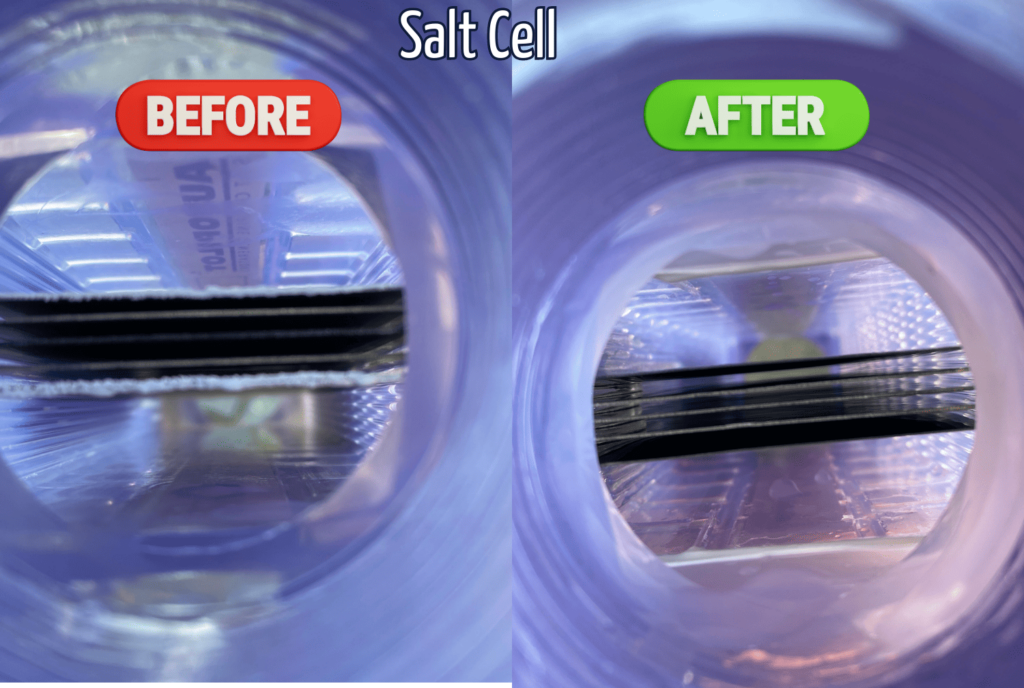
As the main engine behind your saltwater pool’s sanitization system, the salt cell is responsible for converting salt to chlorine.
This process ensures that your pool water is consistently free of harmful bacteria and algae, providing a safe and enjoyable swimming environment.
Without the efficient operation of the salt cell, the water quality can quickly degrade, leading to cloudiness, discoloration, and even unpleasant odors.
Recognizing when your salt cell needs cleaning is crucial for any saltwater pool owner.
A clear indication is a decrease in chlorine levels, even when your salt level is adequate.
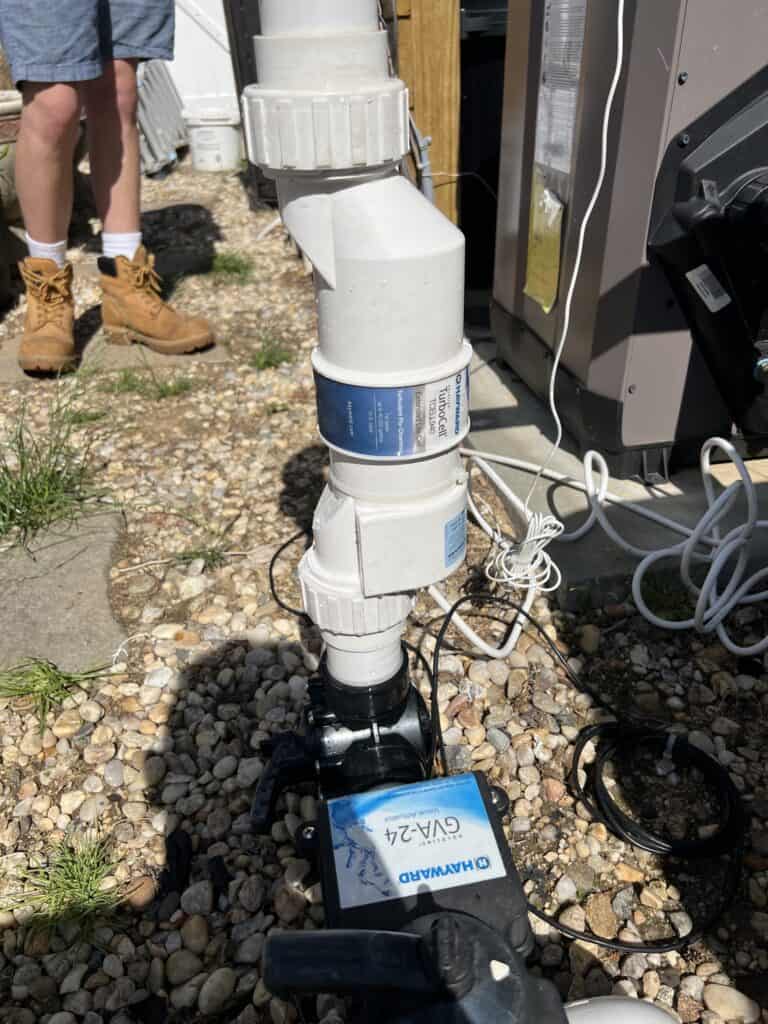
Some modern salt cells come equipped with indicator lights that alert you when it’s time for cleaning. Additionally, if you physically inspect the cell and notice a white or grayish scale buildup on the metal plates, it’s time to roll up your sleeves and get to work.
Regular cleaning schedules can vary depending on usage, water chemistry, and the hardness of your water.
Here are some common signs and error codes that indicate it may be time for cleaning:
Hayward Systems:
AutoPilot Systems:
Error codes can vary across different systems and manufacturers. Refer to your specific salt system’s owner’s manual for detailed descriptions and troubleshooting tips.
However, a good rule of thumb is to inspect your salt cell every three months for any signs of buildup or wear.
Maintaining a regular cleaning schedule for your salt cell has several long-term benefits.
Firstly, it ensures consistent and effective chlorine production, promoting a healthier and cleaner swimming environment.
Secondly, it enhances the efficiency of the electrolysis process, reducing energy consumption and saving on operational costs.
Moreover, routine cleaning can significantly extend the life of your salt cell, delaying the need for costly replacements.
A clean salt cell also aids in maintaining the balance of your pool’s chemistry, reducing the likelihood of problems such as corrosion, scaling, or other water balance issues.
We strongly advocate for proactive care and maintenance. Taking the time now to regularly clean your salt cell will undoubtedly save you time, money, and potential headaches in the future.
Maintaining a regular cleaning schedule for your pool’s salt cell is the key to prolonging its life and ensuring the optimal performance of your saltwater pool.
The frequency of salt cell cleaning can depend on various factors, including the hardness of your water, the frequency of your pool’s usage, and the specific guidelines provided by your salt cell manufacturer.
Generally, we recommend inspecting the salt system cell every three months, but more frequent cleaning may be necessary for areas with hard water or high pool usage.
Cleaning your salt cell may seem daunting, but with some guidance, it’s something any pool owner can do.
To maintain the optimal performance of your salt cell, keep these tips in mind:
Remember, regular and diligent maintenance of your salt cell will ensure it continues to perform efficiently, prolong its lifespan, and ultimately save you time, money, and potential hassle.
Just as crucial as maintaining your salt cell, the debris screen in your pool also plays a vital role in sustaining the health of your pool.

This humble component, often overlooked, is designed to catch larger particles such as leaves, twigs, and other organic materials before they reach your salt cell.
By doing so, the debris screen helps maintain the cleanliness of your pool, enhance the efficiency of your filtration system, and prolong the lifespan of your pool pump.
A ‘check flow’ message on your autopilot system is the most common indicator that your debris screen requires cleaning. This message generally signals that debris buildup is restricting the water flow to the salt cell.
Consistently cleaning your debris screen can help prolong the lifespan of your salt cell and ensure efficient chlorine generation, thus maintaining the health and safety of your pool water.
By preventing debris from obstructing the salt cell, you also safeguard against potential damage and expensive repair or replacement costs, providing a long-term saving benefit.
To maintain optimal performance of your salt cell, it’s essential to clean the debris screen regularly. Here is a step by step instructions of the simplified process:
Frequent and thorough inspections of your debris screen are the key to effective maintenance. Regularly clean off any debris and ensure the union surfaces and threads are clean before replacing the screen.
Regular maintenance of your debris screen ensures a healthy salt cell, efficient chlorine production, and ultimately, a clean and safe swimming pool for everyone to enjoy.
Consistent and diligent maintenance of your debris screen will improve the longevity and performance of your pool pump and filtration system. This small task has a significant impact on the health of your pool.
Both the salt cell and debris screen in your saltwater pool plays a crucial role in maintaining the health and longevity of your pool. Neglecting regular maintenance of these components can lead to reduced chlorine production, restricted water flow, and even damage to your pool pump and filtration system.
Remember, the secret to a healthy pool is regular and diligent maintenance. A little time and attention now can save you from a potential headache.
However, we understand that pool maintenance can sometimes be a daunting task. That’s where our professional weekly pool maintenance services come into play.
We have the knowledge, experience, and dedication to ensure your pool remains in peak condition throughout the year.
Don’t wait until small maintenance tasks turn into significant problems.
Book our professional pool maintenance services today, and enjoy the peace of mind of knowing your pool is in expert hands.

We make pool ownership easy with stress-free maintenance, expert repairs, and cutting-edge tech. From sparkling water to pool automation, we handle every detail so you can relax and enjoy your pool.
© 2025 Paul Romanelli & Son Pool Service.